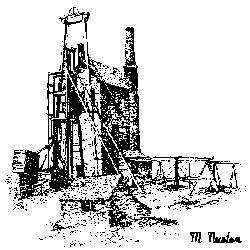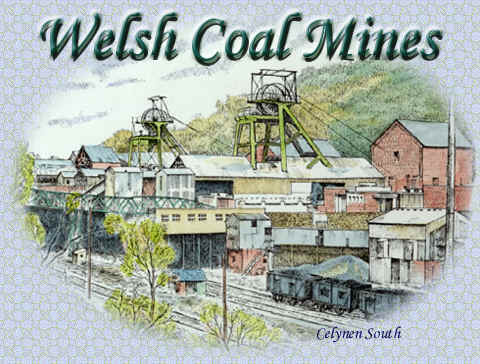David 1797-1862
David was born in the parish of Bedwas, when Welsh was predominant, possibly in
Maesycwmmer in 1797, he
was born to Lewis and Margaret Lewis, and would have been
baptised at one of the few Independent Chapels in the area, in Penmain a
few miles away.
Archdeacon Coxe toured Monmouthshire
in 1799. On 4th March 1800 at Rudry, Glamorgan across the
county border from Bedwas, the imfamous Dr. William Price was born. Nelson wins
at the Battle of
Trafalgar in 1804, in the same year Richard Trevithick operates his
| steam locomotive
in South Wales. In 1815 Wellington wins at the Battle
of Waterloo. Humphrey Davy starts the first trial of his safety mining lamp on 9th
January 1816. Then in 1820 George IV became King, after his father
goes insane, and around this year Prize Fighting reaches the peak of
it's popularity in the towns of Britain. John Morridge encouraged the
workers in the area to build houses on his land, and pay rent. The
Rock Foundry was developed in 1823. |

|
| David moved to
Llanhilleth, to work for the Union Foundry, just below
Llanerch(now Trinant), the Blaencyffin Uchaff colliery in the mid
1820s, or near Six Bells, where he met a girl from the farming parish of
Aberystruth, |
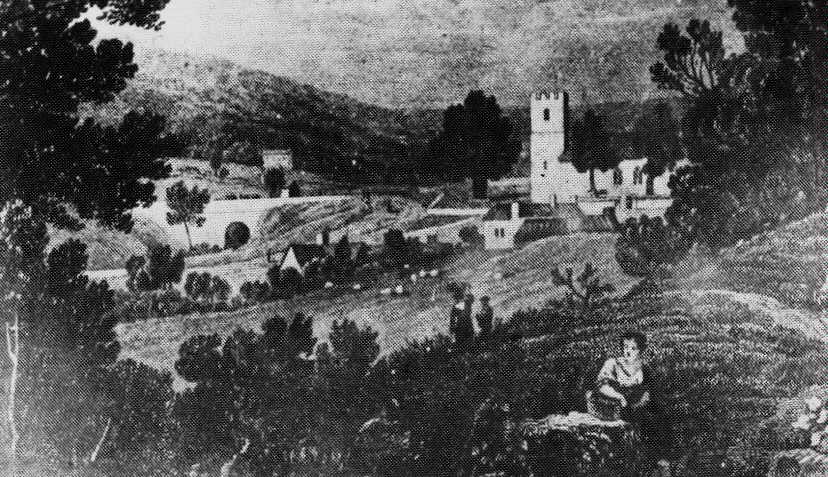
St
Peters Church, Blaina, as drawn in
c1820, which burnt down in 1854. |
widow by her early 20's, named Mary Williams, who he married at St.
Peter's Church, Blaina, Aberystruth on Monday 7th May 1825. Mary was
born before April 1800 in the town of Blaina, and married Mr. Williams
towards the end of the first quarter of the 19th century. Unfortunately
their marriage was cut short by the untimely death of her husband soon
after | their wedding. After David married
Mary they set up home in Cwmtillery, near Mary family. In the
Winter of 1828 they had their first child, a son they named
Ebenezer.They then moved to the Argoed area.
In the
early hours of 29th May 1829
Sir Humphrey Davy, inventor of the Lamp, passed away in Geneva, after
a stroke, and also in that year there was a depression and in
Hirwaun Merthyr a worker named Lewis Lewis had his truck seized. This
contributed to the unrest of the miners and iron workers. The situation
got so bad that the Scots Highlanders at Brecon Barracks were called in.
From this there was a bloody confrontation where fifteen Highlanders
were lost. Lewis Lewis was given the death penalty but instead he was
exiled, but Richard Lewis , known as Dic Penderyn, was executed for
wounding a Highlander. A man whose name was Parker having migrated to
America confessed on his death bed that he had wounded the Highlander and so Penderyn
became a Martyr. In 1830 William IV became King , and the Napoleonic wars came to an
end. The following year Charles Darwin starts voyage of discovery on HMS
Beagle.
Already working like slaves for only Truck tokens and lodgings,
the miners of Crumlin , having their wages cut, they went out on strike and
demanded the abolition of the Truck System and payment of their earnings
in cash. The Scotch Cattle kept the strike solid, with intimidation, like
the incident, on 12th May 1832, at Blaen-y-Cwm Colliery, west of Pontypool,
when 200 men went there and destroyed working colliers furniture. William
Thomas the poet of Mynyddislwyn was born 3rd April
1832, and Slavery is abolished the following year.
In about 1830 Mary
gave birth to a baby daughter. See was named Martha. David may
well have been a member of the Scotch Cattle, as the Lewis men showed a
keen interest in prize fighting. The winter
of 1833 also saw the arrival of Thomas. Thomas was the second son of
David. Then between March
1836, and the end of that year, when Thomas was around three, another
brother was born, this was Lewis. By 1836 David and Mary and their
young family had moved to Abercarne to work at Abercarne, or Gwyddon
colliery or at Abercarne Iron and Tin company in the south east of the
parish of Mynyddislwyn. Abercarne was the home of Sir Benjamin Hall,
a wealthy English businessman, but one who cared about his workers.
Victoria Became Queen in 1837, and during the time that
followed, there was much industrial unrest due to the people uniting
under the flag of socialism and creating unions to protect their work
and their members in times of hardship. This frightened the government,
and this came to a head when the government prosecuted six labourers who
had formed a lodge at Tolpuddle in Dorset and were transported on a
charge of sedition, which infuriated the working classes. They were The
Tolpuddle Martyrs of 1837. The Chartists rose up on the rainy Sunday
evening of 3rd November 1839 demanding improvements to the Parliamentary
electoral system, and they planned to lay seige on Newport, but they
were met by military force. Zephaniah Williams's Nantyglo met John Frost's Blackwood contingent, and
marched in torentual rain, boldly down Stow Hill to Westgate Hotel,
Newport. William Jones's Pontypool contingent arrived at the meeting place
at Risca late and they missed the march on Newport. The mayor, Thomas Phillips,
with 28 men from the 45th regiment, a
force of special constables appeared at the door and demanded to know
their grievances. A constable was shot, which started a battle, in which
the mayor was shot in the shoulder with a musket. 22 Chartists died outside
the Westgate Hotel, but it is thought that many more died, but were taken
away by conrades to protect their families, and many were injuried. Forty
were arrested, including two of the leaders, John Frost, and Zephaniah
William, and a warrant was issued for Dr. William Price, and William Jones.
A story says that after being warned Dr. Price dressed as a woman and was
escorted up the gangplank by the police inspector looking for him. He
escaped to Paris. William Jones was arrested a week later in a wood near Crumlin. The others were tried
for High Treason and guilty they were
sentenced to
|
death. The sentence was commuted to Transportation to Tasmania.
Although women and children were prohibited from working in the pit from
1842, this practice still continued and South Wales was the worst.
David would probably have been involved in the march on
|

The Newport Uprising in 1839 |
Newport
with John Frost's Blackwood contingent and would have met at the Coach and
Horses Inn late on that wet night.
Because of the disaster of the failed uprising, the authorities were out to
round up as many of these revolutionaries as possible.
So David took his family far from Newport and Abercarne. David found work in Cwm Celyn in the hills above Blaina,
until the authorities had enough to try. Later David moved his
family to Garndiffaith, and probably work in one the nearby iron companies,
possibly New British Iron Company, while David's sons all became miners,
and probably worked at Lower Varteg colliery, or in the British's own pits.
Mary was suffering with rheumatism, and had been for two years. Around the
turn of 1851 Mary went down with Tuberculosis, and on the 17th April 1851 she died.
David was living with William, his younger brother, in Blaen-y-Cwm, up until the earlier 1860s,
and was still there is October 1861 when his second son, Thomas brought his pregnant wife
Amelia there to give birth to their first child. During this time David was receiving assistance.
David was unable to earn money himself through injury in the early
1850s, and he went to the Poor House in Abersychan, where he died from suspected heart disease on 13th June 1862.
It is suspected that he died at around 65 years old.
Family
Tree Thomas
1833-1896
Thomas, the second son of three was born in the
at Argoed in the Winter of 1833 to David and Mary Lewis.
In 1847 the Ten Hour act was passed in which no
child is allowed to work more than ten hours. Merthyr, Dowlais, and
Aberdare suffered cholera epidemics in 1849. In 1851 the Admiralty
decided to use South Wales Coal.
Thomas moved on to the
village of Garndiffaith with his parents and brothers, and eventually he
met Amelia Jayne from the town of Talywain, the daughter of a sawyer,
William and Amelia Jayne. They lived near the Lower Varteg Colliery(later
owned by Henry Jayne in 1898) which was where the Thomas and his brothers
probably worked. Jayne and Company sank another local pit, Milfraen Colliery,
and if they are related to Amelia, this could explain how Thomas became a
pit sinker. Thomas married Amelia in the Pisgah Baptist Chapel, in her home
town on Tuesday 26th April 1853.
The Crimean
War started in 1854.
Thomas and Amelia set up home at Sow
Hill, Tranch west of Pontypool. Thomas's father was living at the top of the next
valley of Cwmffrwdoer, at Blaen-y-Cwm, with the family of his young Brother
William.
The ill fated Cwmnantddu colliery(later called Llanerch) was
sunk by Ebbw Vale Company in 1858. Pontypool Free Press and Herald of the |
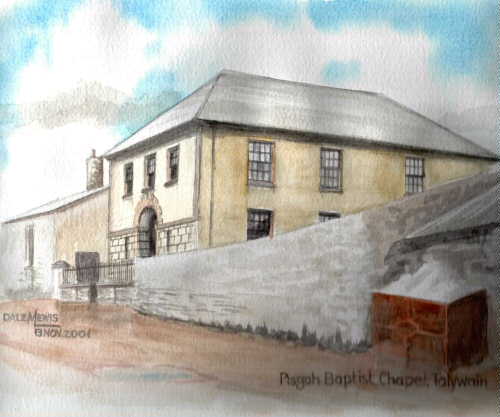
The Pisgah Baptist Chapel, Talywain, where Thomas
and Amelia married |
Hills were established in 1859.
Kear's(Kearsley) and Varteg pits were sunk in 1860. The British Top
pits are sunk, 15,000 people attend the funeral of Capel Hanbury at
Trevethin Church in 1861, and Lord Llanover replaces him as Lord
Lieutenant of Monmouthshire.
In October Thomas had taken Amelia to his Uncle William's house, in Blaen-y-Cwm,
where his father, David, was living when Amelia was close to giving birth
of their first child. William was David's younger brother, and his
wife, Rachel, could help with the delivery of Amelia's first child. On Wednesday 9th October 1861, with Rachel's assistance,
they had a
son, and they named him Thomas after the child's father. At home in Sow Hill Thomas was
probably working, and sinking pits in the local area, and working with Ebenezer at the Tranch Colliery. Among the pits
he sank during this period, may have been the ill-fated Llanerch colliery sunk in 1858.
In 1862 Races are held in Pontypool for the
first time since 1850, and the Vancouver goldfields open, drawing
dozens of families from Pontypool.
At some time Thomas's family moved to Cwmffrwdoer to work at the Big Jack pit there. In Pontypool in the Autumn of 1863 Amelia
had a second son. He was named after Thomas's
father David.
Blaendare pit was sunk in 1865.
Dr Barnardo's first home for destitute children was opened in 1866,
and the following year The Parliamentary Reform Act of this
year gave the vote to every male householder in the boroughs and to
every male householder in the counties with premises rated at 12
pounds or more. Overnight, almost 60,000 new voters were created
in Wales, the majority voting Liberal in the next election and
shattering the political power of the great Tory landlords and
industrialists in Wales.
Back in Tranch Amelia had a baby girl they named Eliza Ann, after Lewis's
first daughter, and wife, in 1868, and on Monday 30th May 1870 another
son was born and like Thomas's Uncle, and Amelia's father was named William.
In 1870 telegraph wire connected Pontpool to Newport. On 1st June 1871, the miners
of Aberdare and Rhondda went out on strike for an extra 5%, and on 9th June Dr
William Price address the strikers at Aberaman, decrying
the colliery owners greed.
In Cwmffrwdoer in the Autumn of 1872 Amelia gave birth to a second daughter, Sarah Ann.
In 1873 the beginnings of trade unionism seemed to
threaten the enormous power wielded by the coal owners who formed the
Monmouthshire and South Wales Coal owners' Association (MSCA) in 1873,
to present a united front against their workers. Two years later, the
Association was able to introduce the system of payment known as "the
sliding scale," setting wages to the selling price of coal.
In the Spring of 1874 Amelia gave birth to a third daughter
the same as herself and her mother.
There was
a 5 month general strike and lockout in the monmouthshire coal fields 1876 sees
the closure of the British Iron Company. In 1877
following years of constant defeats in their battles against the coal
owners, the workers were persistent in their attempts to form unions.
Also in 1877, the Cambrian Miners' Association, founded in the Rhondda
Valley, began to organize strikes as their only resource against the
MSCA.
Around 1878 Thomas was probably working at the sinking
of Tirpentwys with his eldest son, Thomas. Also in this Winter Thomas and
Amelia gave birth to another son, who like his uncle was named
Lewis. At this time Thomas's brother Lewis came back from the Rhondda to work in Cwmbran, so Thomas moved the family down
to join Lewis's family.
Britain Annexed Africa in
1880. Kearsley Pit was deepened in this year and renamed"Big Pit"
Thomas and his family had moved to 2, Fairwater Cottages where Lewis was also living(appearing by it's
nickname New Town in the 1881 Census, and now called Fairwater Close),
which was near Cwmbran, possibly to help sink the Cwmbran Main Audit Colliery which was nearby.
Lewis and Elizabeth had another daughter in 1879, but they soon were asked to Roath, Cardiff so Lewis could be a baptist
minister, so they left. David went to Risca and Young Thomas to Ebbw Vale.
Around this time Thomas was also working away from home a lot. I think
he was helping with the sinking of pits,
leaving Amelia in Cwmbran to look after the
family, herself working as a housekeeper and her eldest daughter,
Eliza Ann, working as a domestic servant, possibly hired by St Dials House, nearby.
In January 1881 Amelia had another son called Albert, but I believe
he had died before his second birthday. At this time Thomas had returned
to the Tranch, working at the new Pit near his lodgings at Cwmffrwddoer, called
Tirpentwys, maybe to set the charges in it's sinking. Young Thomas married in 1884.
Benz developed the
first automobile in 1885, but the horse would be the main means of
transport for another 30 years. In 1887 Measles hit Sebastapol, where of the 130
cases 14 were fatal
The Family returned to
Tranch, but in late January 1888 bad news came from Elizabeth in Roath. Lewis had caught
Pneumonia and on 23rd January 1888 he died. Thomas took William, and young Amelia to Roath and helped Lewis's family move to
Ystrad. After Thomas and his youngsters travelled on up to Penhriwceiber, Mountain Ash, where his older brother Ebenezer was
working. David had travelled up to work with Ebenezer a few years earlier and met and married a girl named Harriet in around
1886. Shortly after the New Year of 1889 Ebenezer's worsening chest problems turned to Dropsy, and on 11th April Ebenezer
died. William was at his bedside. After they had arrived in Penhriwceiber Amelia soon found a man named Morgan Roberts from
Cardigan, and they married on 14th July 1890. Also that same summer Sarah Ann had married Oliver George Barnes in Pontypool.
All the daughters were married, but Sarah Ann and her
husband, stayed with Amelia in Twistle's Row in Tranch until they could find a home. Thomas moved Amelia to Tonypandy,
but he was very involved with a woman named Susan and were like husband and wife and this may have been going on while Amelia was
in Cwmbran. It is said that they even had a daughter together but she died in infancy. Apparently Thomas worked extra back to back
shifts to pay for her funeral, and when he eventually came out of the pit he acquired the name Rough which reflected his appearance.
William had married Selina Roberts the sister of Morgan but she died during childbirth.
William fell for his cousin, Sarah Ann, and were living at 32 William Street, Ystrad and
in 1893 William married his cousin. William and Sarah had a daughter named Sarah and then another
named Blodwen. William's young family moved to near Six Bell where Thomas was working. Young
Amelia and her husband Morgan moved to 64, Charles Street, Llwympia. Thomas then died about this time, so Amelia moved in
with young Amelia. Amelia had a stroke and died there on 3rd October 1907. She was about 74 years old, her daughter Amelia
and Morgan were at her bedside.
Family
tree Thomas
1861-1929
Thomas was the first born of seven
children and named the same as his father. He was born in Blaen-y-cwm
on 9th October 1861 to Thomas and Amelia Lewis, because Thomas was
working away from the family home in Tranch. Eventually Thomas's father moved him
and his whole family to the town of Cwmbran, possibly to work in the
Cwmbran Audit Colliery which was nearby, where they would have worked
together.
|
In the early 1880's he was living in Nantyglo, and
perhaps working at the Coalbrookvale Colliery. He met
Mary Davies,
who was born in Llanhilleth to William and Ruth Davies in about 1862. Thomas
married Mary on Monday 14th July 1884, at the Holy Trinity Church in
Nantyglo, they then moved to Mount Pleasant, Blaenau
Gwent,
|
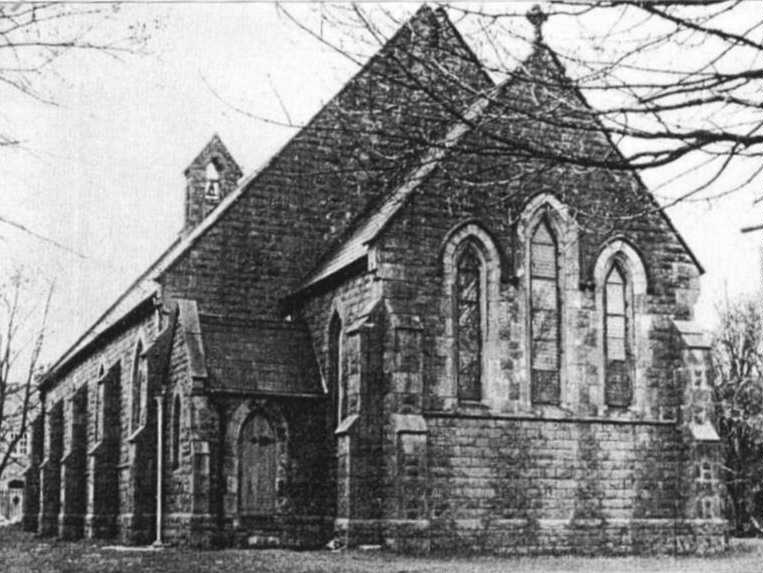
Holy Trinity Church, Nantyglo |
|
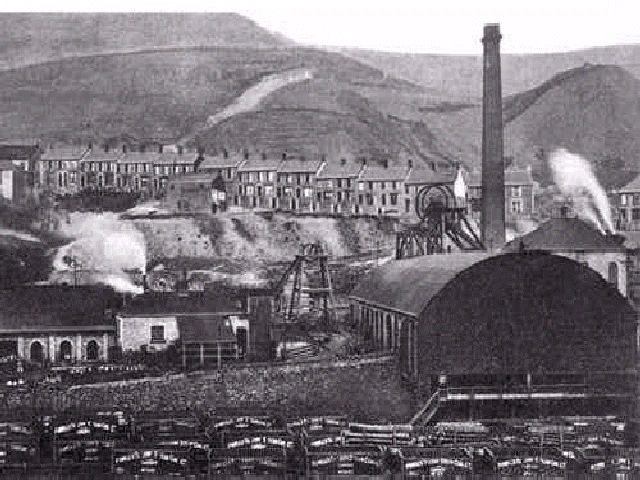 Tillery Colliery viewed from
Mt.Pleasant
Tillery Colliery viewed from
Mt.Pleasant |
Abertillery, probably working at the Tillery
Colliery(later called Penybont Colliery) which was in plain view of his
home. On Friday 22nd January 1886 Thomas and Mary had their first child,
a daughter they named Blodwen Ann. A couple of years later on Tuesday
10th July 1888, they had a son they called Thomas, like his father.
|
In South Wales in 1893 the Labour Party
was formed. In October 1899 the Boer War started.
Thomas and
his brother William had been prize fighters, and were nicknamed the
"Rough" brothers, Will Rough and Tom Rough. In the mid 1890s Thomas
fired the shot in the team that sank the Six Bells pit near Abertillery
where he was then living.
However on Saturday 9th February 1895, Thomas Day, John
Lambe,
|
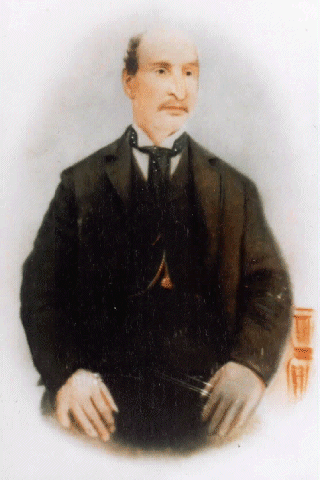
Thomas Lewis June 1906
the summer of
1901 it had be- come acute. On Saturday 24th August 1901 Mary died.
Edward VII became King in
|
William Mathews, and William Lusty were killed when the bowk they were riding
in capsized and sent them plummetting to the bottom of the shaft,
during the sinking of Six Bells.
Thomas's life then hit bad times, because his
wife, Mary, caught Tuberculosis and by 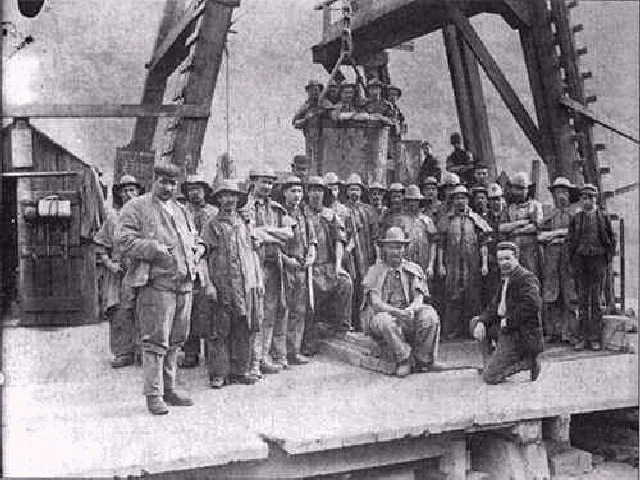 The Sinking team of the Six Bells Pit
The Sinking team of the Six Bells Pit
Click on to
enlarge |
1901, and the Boer War ended
1902. On 17th December 1903 the Wright brothers made their first
flight.
Seven years after Mary died Thomas's son Thomas went
down with Pneumonia, and on Thursday 27th February 1908 he died. Thomas
was aged about 19, and he was buried with his mother in the Blaenau
Gwent Baptist Church cemetery.
After the death of his wife, Thomas
began courting an abandoned mother named
Elizabeth Jane Oliver, from
Pontypool, because Thomas's younger sister, Sarah, knew her through her
husband, Oliver Barnes, who was the older brother of Elizabeth's absent
husband, Samuel
Barnes, who left her with two sons to care for. think Sarah nd Oliver introduced them to eachother. Elizabeth worked as a
seamstress at Gillots, Pontypool. During their courtship Thomas one day came to
Elizabeth's door and produced a hat full of gold crowns, which he no
doubt won in a Prize Fight. Elizabeth didn't care for this fighting, and
as Thomas already in his forties stopped fighting. Elizabeth and Thomas married on 3rd September 1910 at Pontypool Registry Office. Whether marriage was
proposed or whether Herbert and Samuel were in favour of the marriage became academic because
Elizabeth was about three months pregnant on their wedding day. Before the
wedding Thomas stayed with Sarah, a few door's away. After Thomas moved into Elizabeth's home, and Thomas worked at
Tirpentwys Colliery where Sarah's husband, Oliver worked in the office.
On 6th December 1910 Elizabeth
gave birth to a son. I believe he was supposed to be named Lewis Reginald, but he was
registered Louis Reginald. So after his registration on 17th Jauary 1911 Thomas moved his new
family to newly built Church View, Woodfield Side across the Sirhowy from Blackwood. Elizabeth
instructing young Samuel to use his middle name, Lionel. The military may have been looking
for an Elizabeth Barnes and her two sons, Samuel and Herbert, in Pontypool, not Elizabeth
Lewis and her three sons, Lionel,Herbert, and baby Louis living in Blackwood.
On 6th December of that year Elizabeth gave birth to their first child together,
a son they named Lewis, like Thomasís younger brother and his great grand father, and his late Uncle, the Revrend.
On 11th January 1911 Elizabeth went to register their new son.
When Elizabeth return
she told Thomas that Lewisís name had been spelt wrong. Lewis was now Louis. I think
Thomas would have been very disappointed and angry at this news. After this Louis was always referred
to as Reg, his second name.
They all moved into
Churchview, Woodfield Side, Blackwood, which was a brand new home built and administered
by the Pontypool Landowner, James Jenkins. James Godwin,
but kept in contact with Elizabeth, sending Bobcat pelts for her to make
garments from, using her seamstress experience, and every penny was
welcome.
In 1910 George V became
King.
During this time Thomas took in a Scotsman named
Melville, and a boy from a prison ship, in his charge. This Scotsman was
a Union man, and he made a big impression on the Lewis
household.
Thomas wasn't entirely happy with the letters coming from
Samuel, and Thomas's step sons Herbert and Lionel were a little
resentful that their mother had become involved with him and they didn't
hide their hostility, but after a hard day down the pit Thomas would
rather sit quietly with his dog at his feet.
The first World War began in
1914, the bloodiest battle of the war took place at the Somme in
1916.
On Monday 7th February 1916 they had another son they
named Harold Melville, perhaps after that Scotsman, a few years
before. The landlord of Churchview changed in 1918, when the Shoeing
Farrier,Thomas Whittaker Buckley bought the lease for 1 and 2
Churchview on 26th July 1918.
The First World War ended in 1917, the
Amritsar Massacre took place in 1919, and Anglo-Irish Treaty was signed
in 1921
On 22nd November 1920 Thomas purchased Churchview from Mr Buckley.
Thomas worked on farms near Ross-on-Wye to earn a
little money, probably during coal mining strikes. The place was probrably at Goodrich which is where his
mother-in-law's mother was born, and his wife's cousins(the Herbert family) still lived
Thomas kept several
canaries for use in the pit, and he kept fuse cable and other explosive
equipment, for his pit sinking duties, under the stairs.
went to the front door of the Lewis House, and
Elizabeth answered, and invited Alfie in. Elizabeth ushered
him to the kitchen where the Brown boys were and where Lizzie was
peeling potatos. When Lizie's brother's saw Alfie they left. Alfie made the excuse that his piano
was out of tune and asked to use the Lewis one. Lizzie was happy to
accommodate him and eventually after a few visits they were caught
kissing. Thomas was very happy about this and Alfie George and Lizzie
soon married.
One Thursday in May 1929 Thomas was working in the
difficult house- hold seam, and at that moment was working coal in a skip off his work-
|
ing place when a 'pumper' went off killing him immediately.
He was sixty seven years of
age. It was the 16th May and he didn't die alone, among the dead was
Felix Lewis, not related, but little more than a boy, but Thomas
left Elizabeth to care for her growing sons. Because his daughter,
Blodwen was adamant that Thomas be buried with
|
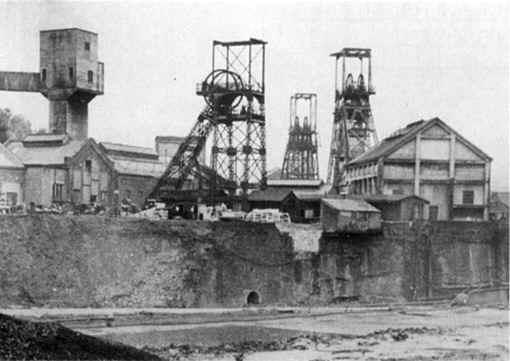 The Waterloo pit(left) where Thomas
died
The Waterloo pit(left) where Thomas
died
|
his late wife, Mary, Blodwen's mother, and
Elizabeth with little financial backing, went along with the decision,
so Thomas was buried in Blaenau Gwent.
Elizabeth took in lodgers at
different times, a Mr Russell imparticular, was a very calming influence
on Elizabeth's sons and grand sons, and he stayed until after Reg died.
Elizabeth died of a Stroke on Tuesday 14th October 1941 at Churchview,
and was buried as Elizabeth Jane Oliver, her maiden name, at Jerusalem
cemetery in Blackwood with her sister Sophie, who had never
married and had contracted a disease which was eating away her face. She
died in a local institution.
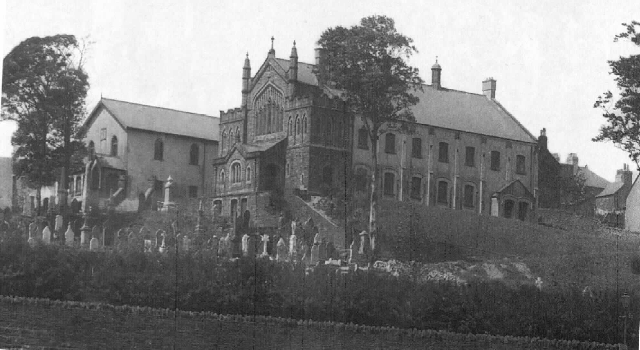 Blaenau Gwent Baptist Church, replaced in
c1940
Blaenau Gwent Baptist Church, replaced in
c1940
Family
Tree
Harold Melville 1916-2002
Harold Melville was born On Monday 17th february 1916 to Thomas and Elizabeth at their
home in Woodfield Side Blackwood. Harold was the second son, six years younger than Reg, and of a second family for both Thomas and Elizabeth.
In Harold's early days at school he often bunked off and went swimming with a girl, Iona
Palmer, at a local quarry, until he went down with Scarlet Fever and then Pneumonia. He survived but he was weakened considerably, and having spent
so little time at school he still could not read or write. When Elizabeth discovered this, she and Reg taught him, and by the
time he had recovered from his dreadful illnesses and was fit to go
to school, his reading and writing skills were close to what they
should have been. A local man named Leslie Cook took Harold and other
families to RAF Athen, to the coast, which helped Melville,s recovery
immeasurably. The illness made him less able to fight off some of
the rough boys of Blackwood, and Pontllanfraith.
Melville achieved a good level of education after his early set back,
and went on to the Pontllanfraith High School. Reg was seen by Thomas
as brighter than Harold, but when they left school they both went to work in Oakdale Colliery.
Elizabeth's sister Rose, in Ilfracombe, would have Reg., Harold, and
Lionel's family to stay. They would catch the Paddle Streamer across
the Severn Estary to Ilfracombe from Cardiff. Rose would give her
nephews money, and in between visits Rose also used to send boxes
of fish by post to Blackwood. Rose and her husband Frank Morris owned
a guest house in Ilfracombe.
Harold worked at Oakdale in the after
leaving School. Aware of the dangers of the Pit Harold and a friend, caught
the bus to Newport and then jumped a train heading for Bristol. |
|







